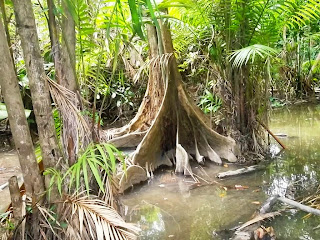The Delta of Orinoco springs from Orinoco River, as it splits into a vast labyrinth of islands and channels called caños that flow for 360km along the Atlantic coast.
It is located in eastern Venezuela, extending from the whole of Amacuro and a bit of the Monagas States.
This is a fascinating region to explore. Last weekend I learned a lot about its fauna and flora when I stayed in Boca de Tigre Island, where I explored a bit of the Manamo, the second largest channel of the Orinoco.
Daily tides bring sea water into the channels, which often inverses the direction of the flow. It is possible, therefore, to have the water flowing in one direction in the morning and then another in the afternoon, which makes it a unique experience. The tide is also responsible for bringing some types of vegetation, the bora, which - if abundant - make navigation difficult.
Dolphins were difficult to photograph.
It seems this was the best photo (on the right) taken with a mobile phone.
Swamp forests are the dominant vegetation of the Orinoco Delta.
 |
| Mangroves |
The river margins of the delta are fringed with mangroves and a variety of palms such as the Moriche.
 |
| The Moriche |
The Moriche provides food for the delta´s inhabitants as well as material for their dwellings, crafts and tools
It is used intensively by the original inhabitants of the Orinoco delta, the Warao tribe (people of the canoes).
 |
| Washing the fiber of the Moriche |
They live in Palafitos (thatched roof huts without walls) along the banks of the caños, and canoes are their only means of transport.
I tried to fish piranas without success, for they ate the meat in the fishing rod and so didn´t let us catch them.
But I did swim in the caños that are their habitat because it was apparently in the program for “tourists” and because natives were doing the same.
The forest also provides a survival kit for natives. They can find food, drinks and medicine there.
 |
| A fruit basket made in the jungle |
Spreading termite ants on your body is a good way of protecting yourself against mosquitoes.
Natives also eat an awful worm called gusano, which they call the Viagra of the forest (I was informed of this by an old man with 26 children).

 |
| blood tree |
This tree is used for communication. When you beat it with a machete it echoes through the forest.
The most beautiful experience I had was to watch the arrival of birds to the Isla de los Pajaros at sunset. There I saw for the first time the Red Ibis of Guyana.
Some natives only speak their own language. I learned Yakera means many things from good morning, thank you, good; and if you want to be nice to someone you say Maraisa (friend). Their language is only oral without any written script.
 |
| Children enjoying a lollipop I gave them |
Sadly, I also learned that the children have a teacher who seldom teaches locals.
What I found very intriguing is that people love their way of life. The forest guide never visited the capital and he didn’t like spending time in the nearest city, Maturin, because it is “very tiring with all those cars”.
Many people there only live until they are 40.
I could not understand what their ambition in life is; perhaps own a TV? Our guide knew Ronaldo well and European teams because he owned a TV, and yet most people lit a fire because there was no electricity available…
Delta of Orinoco, 22-24 May 2015

















































